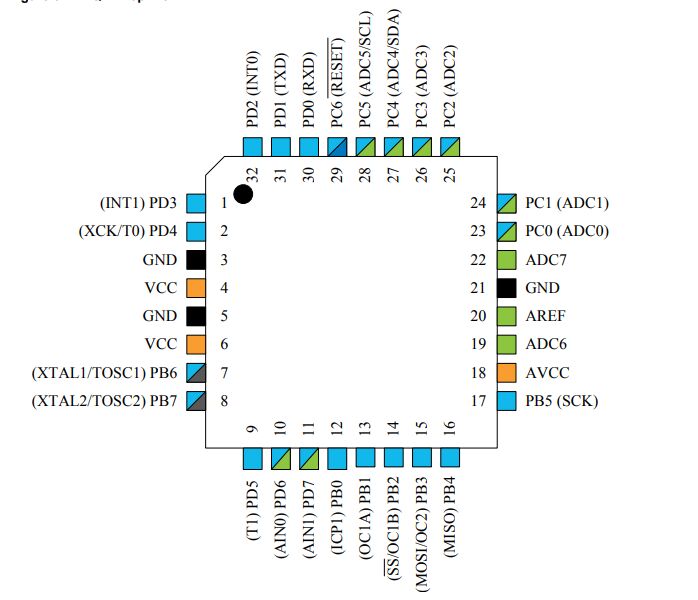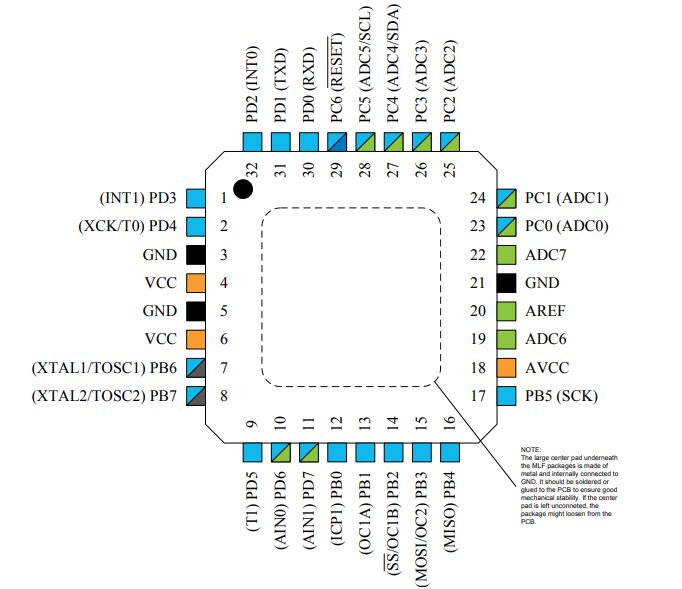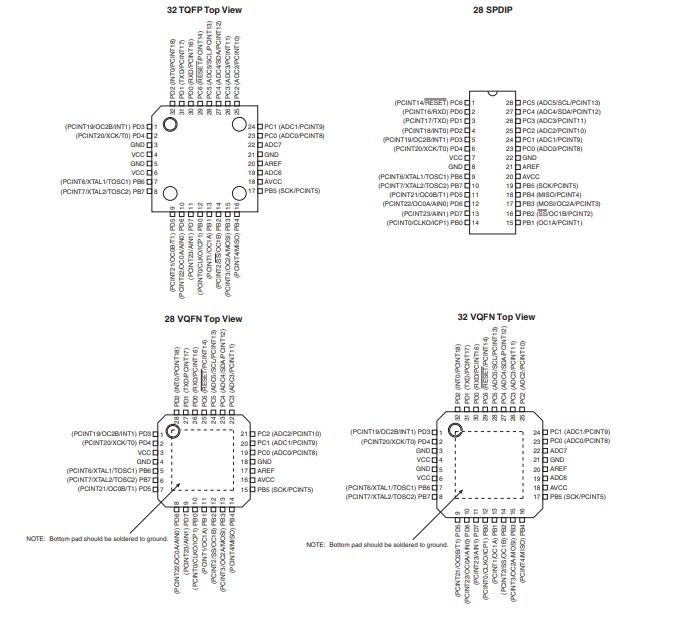By Microchip Technology Inc 264
Ⅰ.Introduction to ATMEGA8A
ATMEGA8A is an 8-bit microcontroller chip produced by Microchip Technology (formerly Atmel) and belongs to the AVR series. It is a low-cost, high-performance microcontroller that is widely used in various embedded systems and electronic projects. ATMEGA8A adopts Harvard architecture and has an 8-bit data bus, suitable for 8-bit data processing.
ATMEGA8A features multiple low-power modes that can be used to extend battery life and is suitable for battery-powered applications. Typically, the ATMEGA8A can run at clock speeds up to 16MHz, providing good performance.
The ATMEGA8A is a low-power CMOS 8-bit microcontroller based on the AVR enhanced RISC architecture. By executing powerful instructions in a single clock cycle, the ATMEGA8A achieves throughputs close to 1 MIPS per MHz. This empowers system designers to optimize the device for power consumption versus processing speed.
Ⅱ.Introduction to ATMEGA328P
ATMEGA328P also belongs to the AVR series. ATMEGA328P adopts Harvard architecture and has an 8-bit data bus, suitable for 8-bit data processing. ATMEGA328P has 28 pins, including digital input/output pins, analog input pins, timer/counter pins, etc., providing a wide range of connection and expansion options. Development for ATMEGA328P usually uses Atmel Studio, Arduino IDE or other AVR programming tools. It is also the core microcontroller of the Arduino Uno development board.

Ⅲ.Characteristics of ATMEGA8A and ATMEGA328P
1.Features of ATMEGA8A
•High-performance, Low-power AVR 8-bit Microcontroller
•Peripheral Features
-One 16-bit timer/counter with separate prescaler, compare mode, and capture mode
-Three PWM channels
-Two 8-bit timer/counters with separate prescaler, one compare mode
-Real-time counter with separate oscillator
-8-channel ADC in TQFP and QFN/MLF package
•Special Microcontroller Features
-Power-on Reset and programmable Brown-out Detection
-External and internal interrupt sources
-Internal calibrated RC oscillator
-Five sleep modes: Idle, ADC noise reduction, power-save, power-down, and standby
2.Features of ATMEGA328P
•Advanced RISC Architecture
-131 Powerful Instructions – Most Single Clock Cycle Execution
-Fully Static Operation
-32 x 8 General Purpose Working Registers
-On-chip 2-cycle Multiplier
-Up to 20 MIPS Throughput at 20MHz
•I/O and Packages
-23 Programmable I/O Lines
-28-pin SPDIP, 32-lead TQFP, 28-pad VQFN and 32-pad VQFN
•Temperature Measurement
-Programmable Serial USART
-Master/Slave SPI Serial Interface
-Programmable Watchdog Timer with Separate On-chip Oscillator
-Interrupt and Wake-up on Pin Change
•Special Microcontroller Features
-Internal Calibrated Oscillator
-Power-on Reset and Programmable Brown-out Detection
-External and Internal Interrupt Sources
-Six Sleep Modes: Idle, ADC Noise Reduction, Power-save, Power-down, Standby, and Extended Standby
Ⅳ.Main parameters of ATMEGA8A and ATMEGA328P
1.ATMEGA8A
•Maximum clock frequency: 16 MHz
•Supply voltage - minimum: 2.7 V
•Supply voltage - Max: 5.5 V
•Data bus width: 8 bit
•Trademark:Microchip Technology/Atmel
•Processor series:megaAVR
•Products: MCUs
2.ATMEGA328P
•Program memory size: 32KB
•Data RAM size: 2KB
•Maximum clock frequency: 20 MHz
•ADC resolution:10 bit
•Number of input/output terminals: 23 I/O
•Supply voltage - minimum: 1.8 V
•Supply voltage - Max: 5.5 V
•Minimum operating temperature:-40C
•Interface type: I2C, SPI, USART
Ⅴ.The difference in memory capacity between ATMEGA8A and ATMEGA328P
1.ATMEGA8A
•Flash memory: The flash memory of ATMEGA8A is 8KB, which can be used to store application codes used by users.
•EEPROM: ATMEGA8A also has 512 bytes of EEPROM for storing non-volatile data.
•SRAM: ATMEGA8A has 1KB of SRAM for storing data and temporary variables.
•Products: MCUs
2.ATMEGA328P
•Flash memory: ATMEGA328P has 32KB of flash memory. Compared with ATMEGA8A, it has more flash memory space for storing user application code.
•SRAM: ATMEGA328P has 2KB of SRAM. Compared with ATMEGA8A, it has a larger SRAM that can be used to store more data and temporary variables.
•EEPROM: Same as ATMEGA8A, ATMEGA328P also has 1KB EEPROM for storing non-volatile data.
Ⅵ.Communication interface of ATMEGA8A and ATMEGA328P
1.ATMEGA8A
•UART: ATMEGA8A supports UART communication, allowing it to transmit data with other serial devices, such as serial debuggers, Bluetooth modules, etc.
•I2C: ATMEGA8A does not directly support I2C communication, but can implement I2C communication through a software library, allowing it to communicate with I2C devices.
•SPI: ATMEGA8A also supports SPI communication, a high-speed serial data transfer protocol commonly used to communicate with external devices such as sensors and peripherals.
2.ATMEGA328P
•UART: Like ATMEGA8A, ATMEGA328P supports UART communication and can be used for serial port data transmission.
•I2C: ATMEGA328P directly supports I2C communication and has a hardware I2C interface that can be used to connect I2C devices such as sensors, EEPROM and other peripherals.
•SPI: ATMEGA328P also supports SPI communication for high-speed serial data transmission.
Ⅶ.Pin diagram of ATMEGA8A and ATMEGA328P
•ATMEGA8A



•ATMEGA328P

Frequently Asked Questions
1.In addition to ATMEGA8A and ATMEGA328P, what other related alternative models are there?
ATMEGA48A/ATMEGA48, ATMEGA88A/ATMEGA88, ATMEGA168A/ATMEGA168, ATMEGA16A/ATMEGA16, ATMEGA128A/ATMEGA128, etc.
2.What package types does ATMEGA8A and ATMEGA328P support?
The packaging types supported by ATMEGA8A: TQFP, DIP, MLF/VQFN; the packaging types supported by ATMEGA328P: DIP, QFN, TQFP, MLF/VQFN, PDIP.
3.What application fields are ATMEGA8A and ATMEGA328P suitable for?
ATMEGA8A application areas: small embedded systems, electronic production projects, education, toy design, auxiliary controllers for electronic equipment, automation and control; ATMEGA328P application areas: embedded systems, electronic production projects, consumer electronics, robotics, automation and Control systems, sensor interfaces, communication equipment.